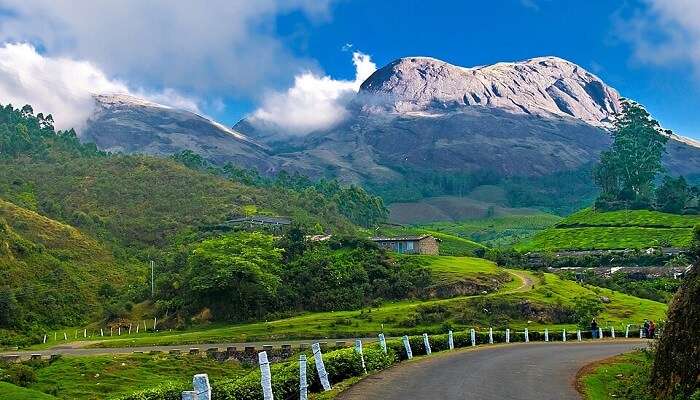Discover The Tranquility In The Divine Aura Of Shankaracharya Temple
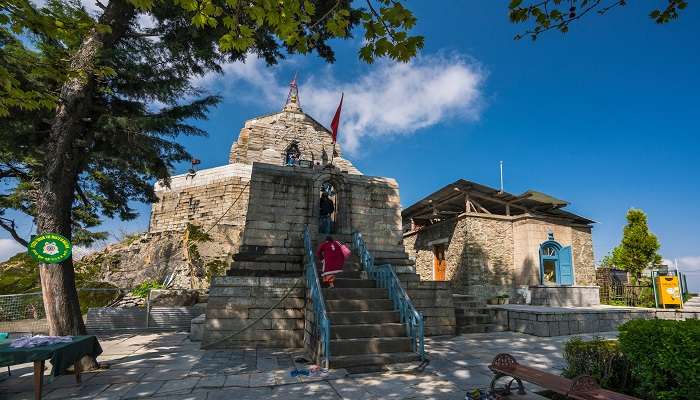
The Jyeshteshwara Temple of the Shankaracharya Temple is a Hindu temple located at the top of the Shankaracharya Hill, part of the Zabarwan Range, in the city of Srinagar in the Indian union territory of Jammu and Kashmir. The Shankaracharya temple is dedicated to the Hindu God, Lord Shiva. The temple is 1000 feet (about 300 m) above the valley floor and overlooks the entire city of Srinagar. The temple draws many visitors, mainly Kashmiri pundits and Hindus, during the festival of Maha Shivaratri or Herath, called locally.
History Of The Shankaracharya Temple
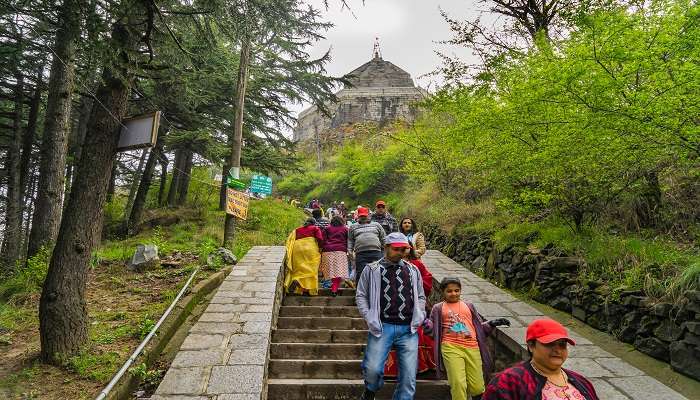
The Jyeshteshwara, or Shankaracharya temple, is considered the oldest temple in Kashmir, both historically and from a traditional perspective. The temple is on a hill, a well-preserved Panjal trap formed by Permian-era volcanic activity. There has been no consensus amongst historians concerning the actual date of construction of the temple. The earliest literary and historical reference to the temple comes from the Sanskrit writer Kalhana, who wrote the Rajatarangini and an account of the history of Kashmir. According to Kalhana, who called this hill Gopadri or Hill Gopa, the Kind Gopaditya granted this land and the land at the foot of the hill to the Brahmins who had arrived from Aryadesha. The writer Kalhana also finally mentions that King Gopaditya built the current temple at the top of the hill as a temple to Lord Jyeshteshwara (Shiva) around the year 371 BCE.
Must Read: Valleys In Pahalgam
Construction And Facilities For Shankaracharya Temple
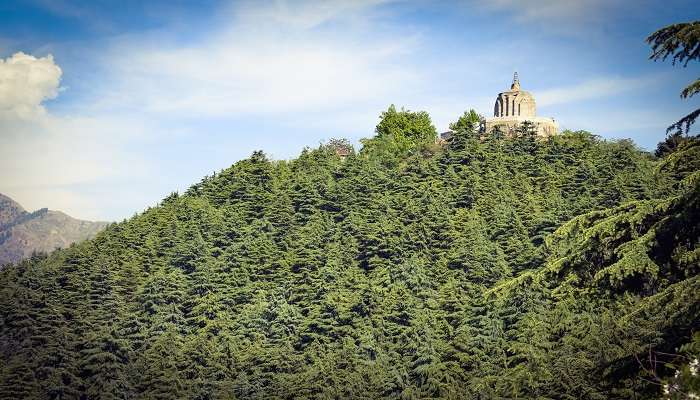
King Gulab Singh, a Dogra King, constructed the steps leading up to the hill from the Durga Naag temple side. There were also steps before, which led further all the way to the Jhelum. Queen Nur Jahan used the stones of the temple steps to construct the Pathar Mosque. In 1925, the Maharaja of Mysore visited the temple and made electrical searchlight installations, five of which were around the temple and one on top. The Maharaja of Mysore also left behind an endowment fund to fund the cost of the electricity bills. In 1961, the Shankaracharya of Dwarkapeetham placed a statue of Adi Shankaracharya in the temple. Sri Aurobindo of Pondicherry also visited the temple in the year 1903. Vinoba Bhave, the famous Indian philosopher, also visited the temple in 1959.
In 1969, the Border Roads Organization built a road measuring 5.6km to the temple. A part of this road was to be used to access a communications tower, which was closed to the public, while the remainder of the road was used by pilgrims going up to the temple. There are currently about 240 steps to reach the presiding deity. The Dharmarth Trust has managed and administered the temple and has built two small shelters for sadhus and holy men. Besides religious tourism, this hill has a very limited amount of activity. The hill sports a large variety of flora. From here, one can see and count the number of boats on the Dal Lake. The river Jhelum is also visible from the top of the hill. The panorama scenery covered major landmarks, including the river Jhelum, the Dal Lake and Hari Parvat.
Architecture And Design Of The Shankaracharya Temple
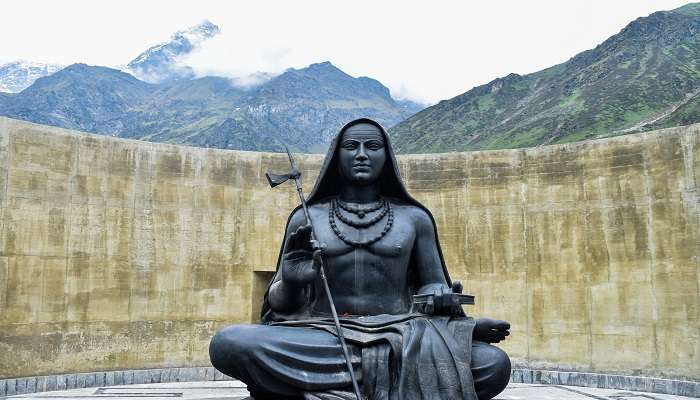
The temple itself sits on top of a solid rock formation. An approximately 6-meter-tall octagonal base supports a square building on the top. Every side of the octagon is approximately 4.5 meters. The flanks, the front and the back are all plain, while the other four sides of the octagon have some minimal designs and noticeable angles. The terrace surrounding the square temple can be accessed by a stone staircase enclosed between two walls. A small doorway on the opposite side of the staircase leads to the interior, which is a dark and small chamber, circular in shape. Four octagonal columns support the ceiling here, and these columns surround a basin, which in turn contains a Shiva Lingam, which a snake encircles.
Suggested Read: Things To Do In Kashmir
Incidents And Popular Culture
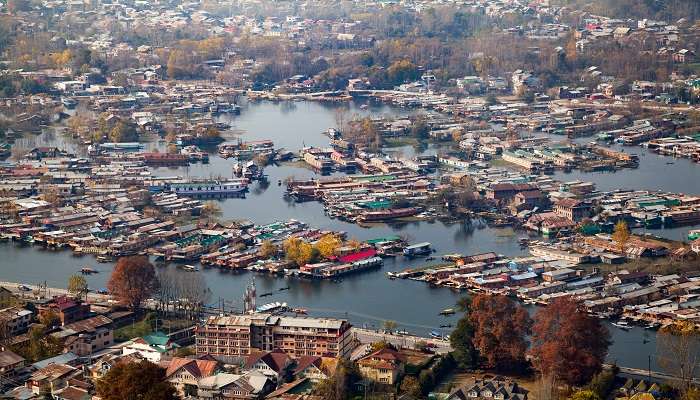
1948 Sheikh Abdullah wrote to the Madras magazine Swatantra about the Shankaracharya temple story. He wrote about how Shankaracharya, who was from the south, came all the way to Kashmir, debated with a lady, and lost the debate, eventually leading to Shaivism’s development all over the country. He further wrote that a memorial to that great event stands tall on the Shankaracharya Hill in the Jyeshteshwara Temple in Srinagar, which contains an idol of Lord Shiva.
The Bollywood films released in 2000, such as Pukaar and Mission Kashmir, feature this temple prominently. The 1974 song Jai Jai Shiv Shankar also briefly features this temple.
So if you are a history buff or enjoy popular culture and entertainment, the Shankaracharya Temple has plenty to offer.
Current Status Of The Shankaracharya Temple, Srinagar, Kashmir
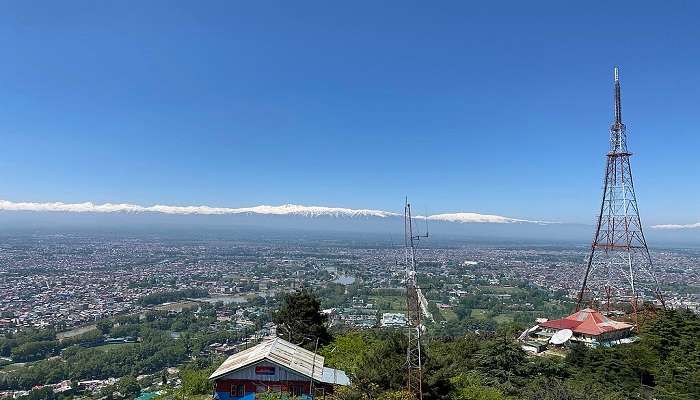
The Jyeshtheswara temple or the Shankaracharya temple features regular worship, and the Kashmiri and other Hindus often visit this temple on their way to or back from the Amarnath Yatra. During the Amarnath Yatra, a tradition is carried out in which, on the lunar phase of the new moon, the holy mace of Lord Shiva is carried to the temple. The Shankaracharya temple is a part of the government’s popular tourist circuits for pilgrims. The temple is lit up to a grand spectacle on the occasion of Mahashivaratri or Herath. In these instances, to prepare for adequate measures for tourists and pilgrims and ensure the availability of all facilities, the district administration reviews all the arrangements to benefit the tourists and pilgrims.
Suggested Read: Festivals In Jammu And Kashmir
Essential Facts To Know About The Shankaracharya Temple

From the timings to the location, you must know certain essential facts about this temple to make your visit stress-free. Here’s the information you must gather before you plan to visit the ShankaracharyaTemple-
-
- Timings: Shankaracharya Temple timings are from 7.30 AM to 8 PM. However, you can avoid the crowded moments and visit the temple in the early morning or late afternoon. Then, you can witness the outstanding sunrise or sunset view from the top of the hill, with the temple beside you. The Shankaracharya temple closes at 8 pm, but you can use the parking lot only till 5 PM.
- Location: The Shankaracharya Temple is located on the Shankaracharya hill, which is also known as ‘Takht-e-Suleiman’. It is in the Durgjan District of Srinagar, Jammu and Kashmir.
- Best Time to Visit: You can visit the temple between March and September. This time in Srinagar, you will have soothing weather instead of the bone-chilling winter that may keep you from visiting.
- Basic Etiquettes: Phones and cameras are not allowed inside the temple. So, keep them in your car or leave them in your hotel rooms.
- Festivals: Maha Shivaratri is the most important festival, and it is celebrated in the temple with pomp and vigour. This is the best time to visit the temple and participate in a grand event. Tourists, along with the locals, participate in this auspicious festival with all their might. Devotees offer Lord Shiva fruits, flowers, milk, and sweets and sing songs to praise the Lord. There can be other occasional festival celebrations as well.
How To Reach The Shankaracharya Temple?
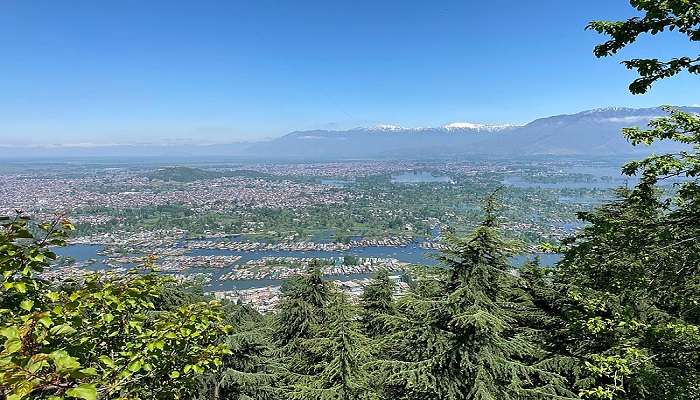
You can reach the temple by road from the city of Srinagar. You can hire a private car or taxi to make your journey smooth. But you can only reach the temple’s base in any vehicle. From there, you must be prepared to climb around 250 steps to reach the temple complex.
Suggested Read: Autumn In Jammu & Kashmir
Suggested Read: Places To Visit In Kashmir In June
Places To Visit Near The Shankaracharya Temple
If you are done offering puja at Shankaracharya Temple in Kashmir and have plenty of time in hand, these are some of the places you must explore;
Dal Lake

It is unnecessary to mention why you must visit Dal Lake in Srinagar. The view around will blow your mind, and floating through the Shikara Ride and viewing the clear water with the Mighty Himalayas Ranges creating the splendid backdrop will leave you in awe. The floating market is also a sight to behold, with local vendors selling snacks and local items.
Mughal Gardens
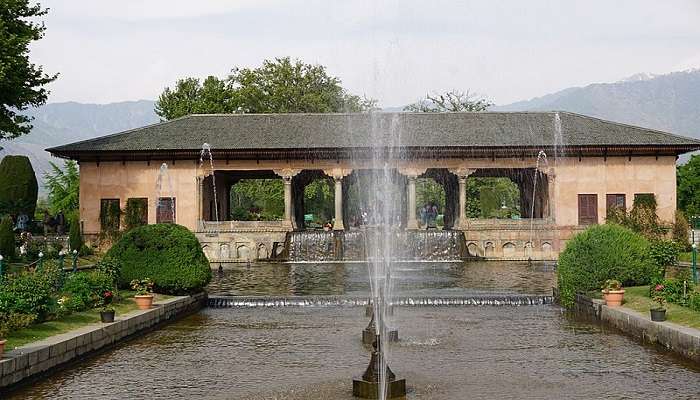
During the Mughal Period, Kashmir was the respite for the Mughal emperors, especially for Jehangir. That’s why he built beautiful gardens throughout Kashmir, including some of the best ones in Srinagar. Visit Shalimar Bagh, Nishat Bagh, and Chasmah Shahi to feel the grandeur of the bygone era still breathing in.
Suggested Read: Places To Visit In Kashmir
Pari Mahal
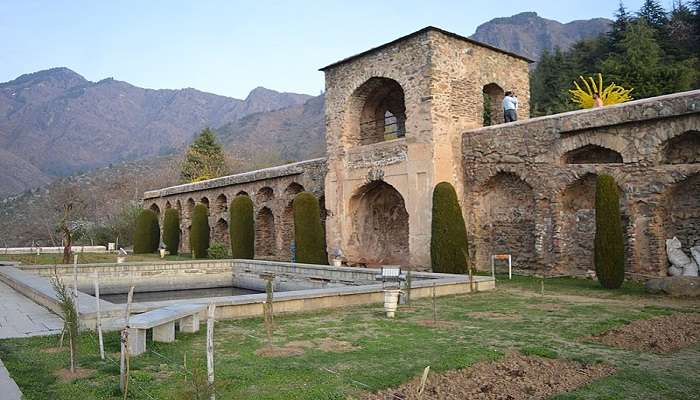
This is another breathtakingly beautiful place made by the Mughal Prince, Dara Shikoh. Get amazed at the beauty of Pari Mahal. It is located on the Zabarwan range and offers a panoramic view of Srinagar. The architecture reflects the taste and class of Mughal culture.
Further Read: Resturants In Srinagar
The Shankaracharya Mandir, or the Jyestheshwara Temple, has a rich tradition and history, so thousands of Hindu pilgrims worldwide visit this sacred temple spot. When you plan a trip to Kashmir, add the temple to your itinerary because it will be an experience like no other. Take your elders and spiritual friends on this unforgettable journey to experience a slice of history and the life of Adi Shankaracharya.
For our editorial codes of conduct and copyright disclaimer, please click here.
Cover Image Source: Shutterstock
Frequently Asked Questions About Shankaracharya Temple
When is the Shankaracharya temple open? What are the temple timings?
The temple is open from 7:00 AM to 8:00 PM every day.
What kind of clothing should I wear while visiting the temple?
Since Srinagar is cold for most part of the year, it is advisable to wear winter clothing and jackets in case the weather is too cold.
What can you see from the Shankaracharya Temple Hill in Srinagar?
The Shankaracharya temple hill in Srinagar offers a splendid view of the Dal Lake, the river Jhelum, as well as Hari Parvat.
What are the different names by which the Shankaracharya Hill is known locally?
The Shankaracharya hill is known traditionally as Takht Hill. Other names that are often associated with the hill traditionally and locally include Koh-e-Seuleman, Takht-i-Sulaiman, Sandhimana-private, Gopadri, or simple Gopa Hill.
Can one visit the Shankaracharya Hill Temple easily on a visit to Srinagar?
Yes, the Shankaracharya Hill overlooks the city of Srinagar. A simple taxi or auto ride can take you to the base of the hill, from where you must climb to reach the temple at the top. Climbing is not recommended as there may be bears in the area. The road ends at another checkpoint where you can leave your phones and cameras in a safety locker.
People Also Read:
Amarnath Yatra Vaishno Devi Temple Trip To Kashmir

With a passion for exploring and travelling to the roads long forgotten, experience the world through enthralling stories and adventures. Join me as I share my experiences at some of the world’s most popular tourist destinations and quench that pestering curiosity with something exciting!




